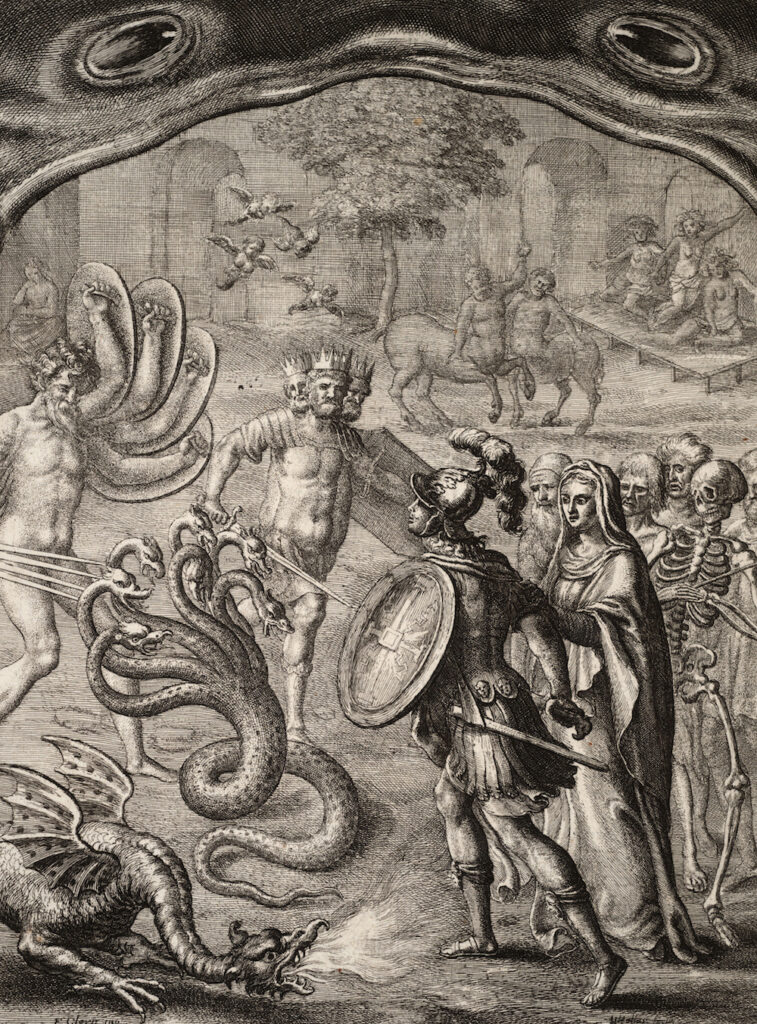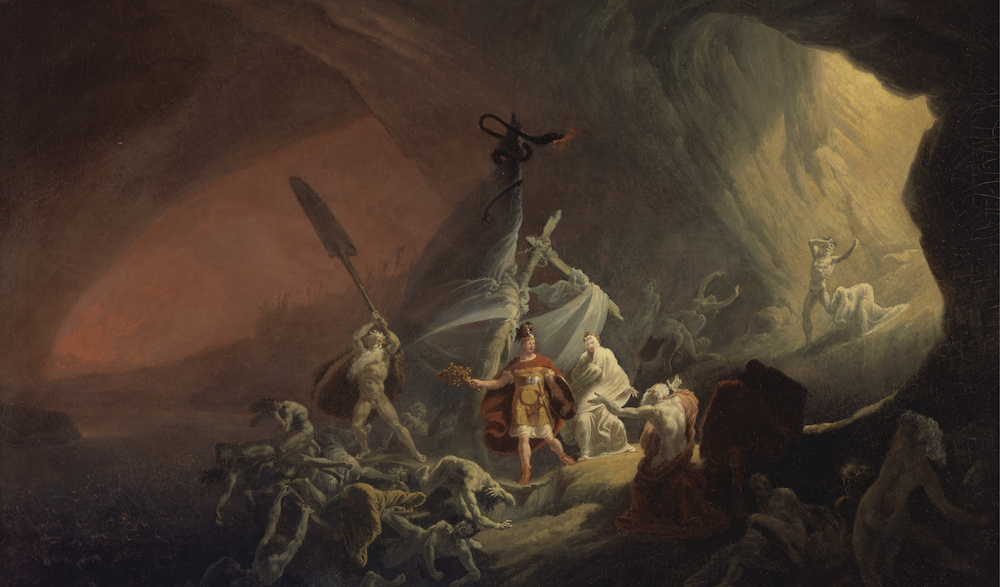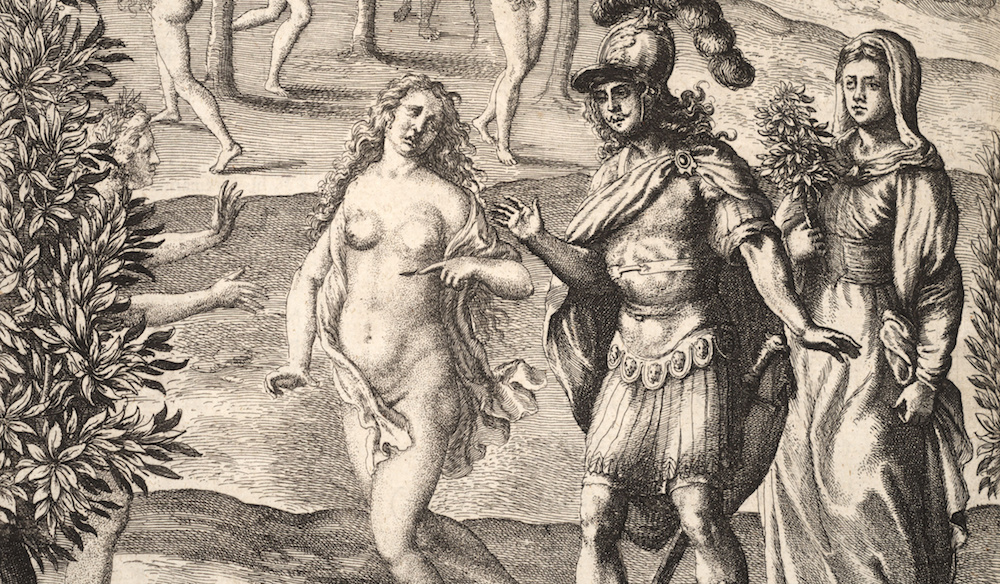Virgil’s Aeneid was Rome’s sequel to the Iliad and the Odyssey. Written almost a thousand years after the first two works, it continues the story of Trojan hero Aeneas after the end of the Trojan War. At one point, his wanderings take him down into the Underworld. Much of what he saw there makes great encounters to add to your extraplanar adventures, prophetic fever dreams, and dungeons. Let’s look at four.

Just past the entrance to the Underworld, there is a vast elm where false dreams cling under every leaf. Lurking beneath the tree are the great beasts of classical mythology: Scylla, the Lernean hydra, the chimera, the gorgons, and three-bodied Geryon. Aeneas quails in fear before them, but his guide tells him not to fear. These are only the beast’s shades. They cannot hurt him.
The combination of false dreams and dead legendary monsters is a good one. Go back through your notes and grab the nastiest monsters from the fights your players still talk about. Stick their shades beneath a creepy tree. Then, when your PCs approach them, have the false dreams flit down from the branches to slip inside the PCs’ heads. Only the most observant characters will even notice it happening. With the party in a half-dreaming state, the monsters will seem to grow in savagery and menace. No longer pale shades, these creatures seem to drip poison and black blood. The players will have to decide how to overcome a hallucinatory obstacle they may not realize isn’t real.

The river Acheron blocks the path to the Underworld. It can only be crossed by taking a ride with the ferryman Charon. Virgil describes a confused scene on the banks as souls clamor to be taken aboard, but Charon refuses them. He will only ferry across the Acheron those who have been properly buried. Those without relatives to bury them, those dead of diseases too terrible for anyone to touch the body, those murdered and abandoned in the wilderness, and all the other unburied dead must wait by the river for a hundred years before Charon will permit them aboard his boat. Aeneas encounters the shade of a helmsman he knew. The man tells Aeneas he drowned at sea and begs the hero to intercede on his behalf. Aeneas’ guide chides the shade, telling him that the commands of the gods are not to be cast aside lightly.
If you have an encounter like this at the table, it works well if you use the shade of a dead NPC whom the PCs knew and liked. It works better if it’s an NPC whose death the PCs caused. If the players feel guilty, they’re more likely to take the bait and try to convince the powers that be to let their friend cross over.

Aeneas encounters other figures from his past in the Underworld. He sees his lover Dido in the Mourning Fields, where those shades consumed by grief for their tragic, all-consuming love affairs wander along secluded paths. Dido was queen of Carthage until Aeneas left her city and she committed suicide. Her shade flees from him, leaving him weeping. In ‘the farthest fields’, Aeneas finds a place where the shades of warriors dwell. He is greeted earnestly by his old comrades from the Trojan War, and his old enemies – the Greek battalions – flee him once again.
If the party has encountered tragedy in your campaign – or if a PC has some unresolved tragedy in her backstory – constructing an appropriate spot for an unanticipated reunion with the shade of a dead NPC could yield some great roleplay. Conversely, a chance to briefly reunite with old friends (or to see old enemies quail before you once more) could make a nice respite in the middle of a tough adventure.
–
The final things Aeneas sees in the Underworld are the Gates of Sleep. As we saw with the false dreams on the elm tree, the Romans associated the Underworld with sleep, so Virgil writes of the place as the source of dreams. There are two gates through which dreams enter the world: one of horn and one of ivory. Prophetic dreams leave the Underworld for the land of mortals through the Gate of Horn. False and delusional dreams pass through the Gate of Ivory. Aeneas leaves the Underworld via the Gate of Ivory, and folks have been debating why ever since. Was Virgil acknowledging his work was fictional? Was he saying that the imperfect world we live in isn’t real? The story doesn’t explain.
At your table, the Gates of Sleep make a great exit from whatever dream, dungeon, or extraplanar adventure your party has been enjoying. Which gate do your PCs pass through, and why? Consider acknowledging your players’ reasons during the PCs’ return to the normal world. If they decide that the PCs, as fictional beings, should take the Gate of Ivory, maybe their return to the world is heralded by an ominous clattering not unlike that of dice. If they decide that the PCs, as characters who believe themselves real, should take the Gate of Horn, maybe they’re greeted by an NPC who’s glad to have them back “in the real world”. Improvise your acknowledgement based on the players’ reasoning.






